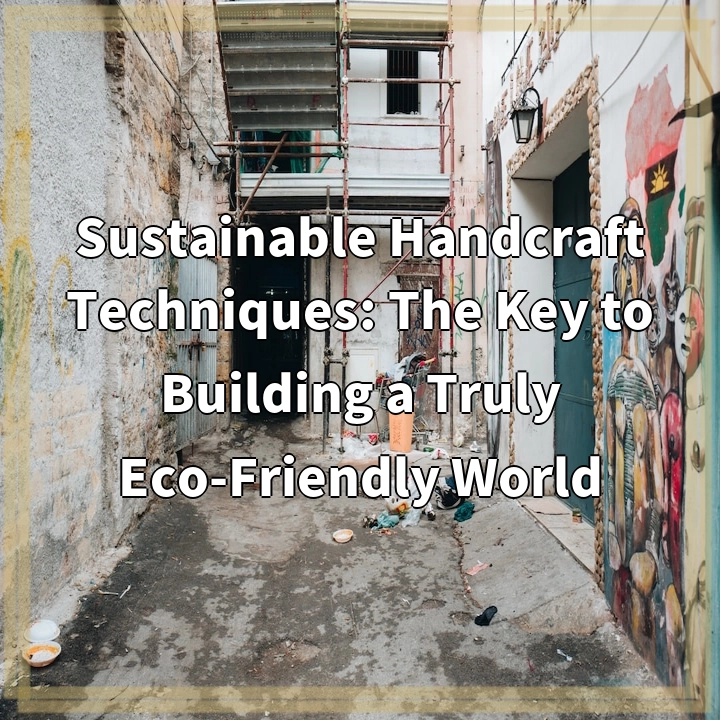
What it is:
Sustainable handcraft techniques encompass a wide range of artistic practices that prioritize environmental conservation and social responsibility. These techniques aim to create products that are both aesthetically pleasing and environmentally sustainable, promoting a more eco-friendly world.
Real-World Problems:
Despite the numerous benefits of sustainable handcraft techniques, there are several real-world problems associated with their adoption and implementation. These challenges can hinder the widespread adoption of sustainable handcraft practices and limit their potential impact.
Lack of Awareness:
One of the major obstacles is a general lack of awareness about sustainable handcraft techniques among both consumers and artisan communities. Many people are not familiar with the concept or the importance of environmentally friendly practices in the art and craft industry. This lack of awareness often leads to a preference for mass-produced, synthetic alternatives that are readily available and cheaper, perpetuating unsustainable production and consumption patterns.
Access to Resources:
Another challenge is limited access to resources required for sustainable handcraft techniques. Artisans often struggle to obtain eco-friendly materials, tools, and equipment necessary for their craft. The availability and affordability of such resources vary across regions, making it difficult for artisans to fully embrace sustainable practices.
Market Demand and Pricing:
The demand for sustainable handmade products can be inconsistent and unpredictable, making it challenging for artisans to create a sustainable livelihood. Consumers may be hesitant to pay higher prices for sustainable handcrafted items, especially when cheaper alternatives are readily available. This creates a barrier for artisans to invest in sustainable materials and techniques and can discourage their efforts to adopt environmentally friendly practices.
Cultural and Artistic Preservation:
Preserving cultural and artistic traditions while adopting sustainable handcraft techniques can pose a unique challenge. Many traditional crafts have specific practices and materials deeply rooted in local culture and heritage. Balancing the need for innovation and sustainability without compromising the authenticity and cultural significance of the craft requires careful consideration and collaboration between artisans, communities, and stakeholders.
Education and Training:
Providing adequate education and training opportunities for artisans to learn sustainable handcraft techniques is vital. However, there is a lack of accessible training programs and capacity-building initiatives that specifically focus on integrating sustainability into traditional handcraft practices. This knowledge gap can hinder the growth and acceptance of sustainable handcraft techniques.
In summary, while sustainable handcraft techniques hold great promise for building an eco-friendly world, there are several real-world problems that need to be addressed. Raising awareness, improving access to resources, creating sustainable market demand, preserving cultural heritage, and enhancing education and training opportunities are all crucial steps towards overcoming these challenges and allowing sustainable handcraft techniques to flourish.

Solutions to Real-World Problems in Sustainable Handcraft Techniques:
Increasing Awareness:
Raising awareness about the importance and benefits of sustainable handcraft techniques is crucial. Education initiatives, public campaigns, and partnerships with relevant organizations can help educate consumers and artisan communities about the environmental and social impacts of their choices, encouraging the adoption of sustainable practices.
Improving Access to Resources:
Efforts should be made to improve access to sustainable materials, tools, and equipment. This can involve supporting local suppliers of eco-friendly resources, establishing resource sharing networks among artisans, and advocating for policies that promote the availability and affordability of sustainable materials.
Creating Demand and Price Incentives:
Building a sustainable market demand for handcrafted products requires initiatives such as consumer education, certification programs, and partnerships with retailers and e-commerce platforms. Additionally, providing fair compensation and pricing incentives to artisans for their sustainable products can make them more economically viable and desirable.
Balancing Tradition and Innovation:
Preserving cultural and artistic traditions while incorporating sustainable techniques is possible through collaboration between artisans, communities, and experts. Incorporating sustainable practices into traditional designs, developing eco-friendly alternatives to traditional materials, and encouraging intergenerational knowledge exchange can help strike a balance between tradition and innovation.
Enhancing Education and Training:
Establishing accessible training programs and capacity-building initiatives focused on sustainable handcraft techniques is essential. This can involve partnering with educational institutions, non-profit organizations, and experienced artisans to provide skill development, technical knowledge, and business training to aspiring and practicing artisans.
By implementing these solutions, the challenges associated with sustainable handcraft techniques can be overcome, enabling artisans and consumers to contribute to building a truly eco-friendly world.















